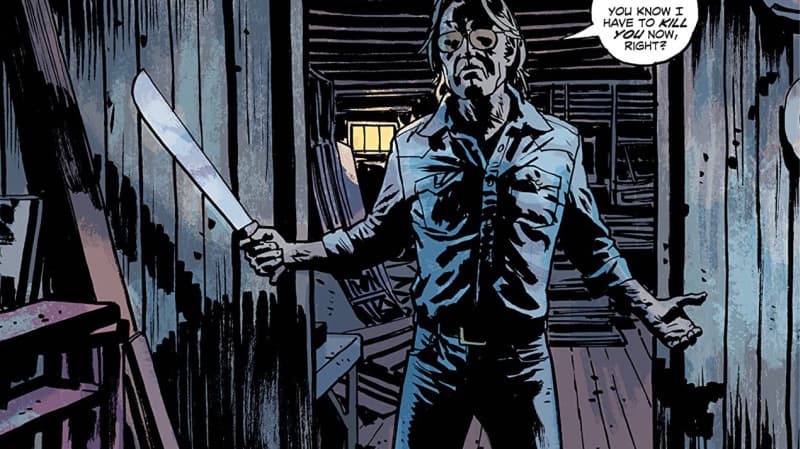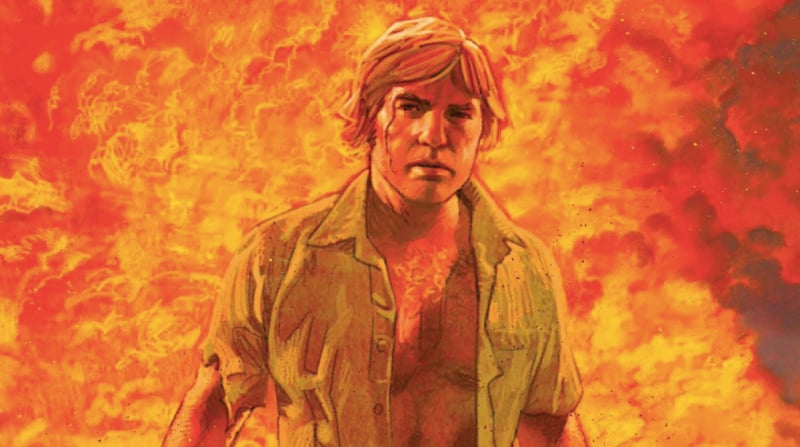[ad_1]
Welcome to Pitch Meeting, a monthly column in which we suggest an IP ripe for adaptation, then assign the cast and crew of our dreams. In this entry, we’re pitching an ongoing franchise based on the Reckless series written by Ed Brubaker and illustrated by Sean Phillips.
In a jam, who ya gonna call? Someone meaner than the brute on your back. Ethan Reckless, not really a P.I., not really a goon. He’s somewhere in the middle, one of the fallen, eager to take on fellow heavenly castaways.
The movies are littered with all kinds of hardboiled heavies, guys who push harder than you know they should, but still not as hard as you want them to. Sam Spade. Jake Gittes. Jack Reacher. There’s something hangdog about them, but when you need them, they’re there. Your admiration stems from their vicious tenacity. They don’t let go. Ever.
Reckless is a new graphic novel series by Ed Brubaker and Sean Phillips and published by Image Comics. It doesn’t mess around with single issues and the long draw between them. So far, the series has dropped two sizeable books, each one representing a full story packed with brutality, mayhem, and dogged pursuit. The third one, Destroy All Monsters, is scheduled to drop in October, and for those that have already grazed from this gnarly, malicious universe, it’s the most anticipated comic of the year.
And yeah, they would make for a helluva movie. Or franchise. We’ll get to that in a sec.
Along with Steve Epting and a host of other artists, Brubaker crafted one of the definitive Captain America runs. He brought noir menace to the star-spangled man and returned Cold War paranoia to a character far removed from those historical events. In addition, Brubaker resurrected Cap’s long-dead sidekick, rebranded him The Winter Soldier, and reexamined what it meant for Steve Rogers to wear the flag and what it would take for others to follow in his footsteps.
Brubaker’s Captain America hums throughout the Marvel Cinematic Universe, and its most recent entry, The Falcon and the Winter Soldier, has once again attracted eyes to this seminal superhero work. Attention that apparently burns painfully within Brubaker. As he recently explained in a Fatman Beyond interview, the author receives very little compensation beyond a “Thank You” in the credits from Marvel Studios, and whenever images of his Bucky Barnes beam from movie posters, his heart cracks a little.

Work-for-hire is a thorny bastard. After a while, many artists retreat and attempt creation independently or with a partner like Image Comics that offers a significantly more friendly creator contract. Unfortunately, from those hopeful folks, not all succeed in finding a significant audience.
Not so for Ed Brubaker and Sean Phillips. Since Sleeper, their first extensive collaboration, the writer/artist duo have worked tirelessly establishing a savagely readable universe of crime-based comics. From Criminal to Fatale to The Fade Out to Kill or Be Killed, not a one is a dud. Quite the opposite, each comic falls on the masterpiece spectrum, which you prefer is simply due to your proclivities.
Now, after twenty years of hammering it out, Brubaker and Phillips have sharpened their partnership into Reckless. Pulp paperbacks and film noir are entrenched inside the comic. The characters are bastards but always rootable (as in, you’re happy to root for them, but also, yeah, I mean that other thing too), especially when compared to the villains delivering harm with every breath they take.
Both books center on nineteen-eighties L.A. Ethan narrates from the present, highlighting the enormity of P.I. work minus Google and other Internet conveniences. Jesus Christ, so much microfiche. In looking backward, the reader gains the impression that Mr. Reckless has seen a lot worse since the events being told, and the possibilities of those tales being explained someday in another book leave you with a tingle. If you think this is bad, just you wait. The next story will be even worse.
The urge is to adapt the first book first. It would make for a fine beginning, as it probes Ethan’s past and somewhat explains his slip from grace, tumbling out of the F.B.I. and into a ratty movie theater where he takes calls and builds his caseload. The first Reckless doesn’t give you all the answers regarding its hero’s motivation, but it rounds out his psychology enough, using a job that’s directly tied to his old life.
Never mind the beginning. Or, at least, let’s come back to it in the sequel. The second Reckless book, Friend of the Devil, should be the first Reckless movie. The comic starts mid-action. Ethan on the run from some skinheads. They ram him offroad and meet his huddled body with cocked shotguns. The story then jumps back a few weeks to explain how our titular lunkhead found himself in such a pickle. It’s an old narrative chestnut, but one Brubaker delivers on.

Friend of the Devil reveals how one missing person case can lead to another and how each case is a different animal. Flatfoots should make the Scout motto their own—always be prepared. Ethan agrees to track down a local librarian’s sister, and the investigation leads him into Roger Corman’s Hollywood and the B movie monsters and devils who operate well below him. Neo-nazis, Satanists, and worse – wannabe producers, oh my.
There’s nothing in the Reckless plots that make them stand apart from the genre staples. Its uncommon nature stems from the telling. Brubaker has devoured and absorbed the best: Hammett, Chandler, Westlake, etc. Their voice spits through his.
Reckless goes to the next level through Sean Phillips. His figure-work is grounded in the recognizable. These are not muscle men or scream queens. They’re the sunken-faced ghosts you see wandering urban alleyways or hugging dive-bar stools. They’re the lost and the lost fighting to be found.
Too often, comic book adaptations latch onto plot and character and forget the medium’s most important aspect, the art. Any Reckless adaptation must adapt Phillips’ characters and style. That means more than casting and costuming. That means adhering to his paneling, the edits found between them, and his shadows. Maybe even more importantly, digging into Jacob Phillips’ wild coloring.
Reckless‘ palette is crated through emotion. The lighting and the shadows don’t match reality. The Reckless adaptation has to toss nature out the window. Gels, gels, gels! We need blues and blacks, but we also need reds, pinks, oranges, and yellows. Don’t care what the sun creates; make what the characters are experiencing. Match their pain with a red flaming hellish hue, their sorrow with midnight blues, and screw whatever time of day it is or where the sun hangs in the sky.
Before you fill any position on the Reckless movie, you gotta nail the cinematographer. Get me P.T.A.’s go-to shooter, Robert Elswit. His films run the gamut as far as lewks are concerned. He can plop a potboiler in his sleep (Skyscraper, Salt, Gigli), but it’s in Inherent Vice, There Will Be Blood, and Punch-Drunk Love where I see Reckless. Colors blur and blend magically in those three flicks, meeting performers where they take their characters.
As far as directors are concerned, let’s have faith that a franchise is inevitable. Rotate the helmers like they used to do with the Mission: Impossible films. Give Friend of the Devil to Gareth Evans and Destroy All Monsters to Brandon Cronenberg. They’re run-and-gun filmmakers who aren’t afraid to let style be the substance. Both also relish in good old-fashioned ultra-violence, cuz make no mistake, Reckless has gotta hit hard. Think in terms of Nicholas Winding Refn’s Drive. The story is not wall-to-wall bloodshed, but when the movie goes red, it goes really, really red.
For the bruiser at Reckless‘ center, we need an actor who’s been through it. But maybe we should cast two actors in the role. One to narrate from the far future, putting on his best Clint Eastwood voice, and another to deliver the punches and take the kicks onscreen.
Could we actually get Clint Eastwood? Nah. And we don’t wanna. Too on the nose. How ’bout Bruce Dern as the unseen Old Man Reckless? He can do brutal and broken at the same time. And in the role of his young punchable counterpart, Logan Marshall–Green. You’ve seen Upgrade. You know he can take a beating and keep on ticking.
Reckless on the page is all attitude. And a project like this one is clearly planted in nostalgia. That’s the pleasure, but that’s also the trap. Watch your step.
Reckless doesn’t feel like a wannabe because it doesn’t look like an old comic, and it doesn’t strive to be an old comic. The film should follow suit. The trappings are familiar, but Elswit and Evans can’t chase the noir. If they chase Jacob Phillips’ colors and Sean Phillips’ lines, the film will find the new. It will be a visual shock to double the narrative’s thwack.
[ad_2]
Source link